Abstract
Common beans (Phaseolus vulgaris) are an important source of protein for the Brazilian population. They are cultivated all over the country, in three cropping seasons/year, totaling 2.7 million tons, mostly for domestic consumption. Pest management is a big challenge and is mostly carried out with the intensive use of pesticides. Integrated pest management (IPM) is essential for sustainability. This technology is based on applying insecticides only when the pest population reaches the Economic Threshold. For that, it is necessary to monitor the crop for the occurrence of pests and beneficial arthropods. Although the concept of IPM and its benefits have long been known and widespread, it is not clear whether bean producers adopt the technology, since informal reports suggest that preventive insecticide applications are still highly used in the crop. The objective of this study was to survey the level of IPM adoption among bean producers in different regions of Brazil, using a questionnaire, applied to 103 producers/consultants. The results show that the estimated rate of IPM adoption by common bean producers in Brazil is 46.6%. The main causes of the low adoption are a lack of understanding of IPM concepts, high confidence in the efficiency of pesticides, and high costs of crop monitoring.
1. Introduction
Common beans (Phaseolus vulgaris) are one of the most important sources of protein for the population of developing countries, feeding over 300 million people daily worldwide [1,2,3]. Common bean consumption is also part of the traditional food culture in many places; common beans are a part of typical local recipes and people’s history. In Brazil, common beans are consumed by people from all economic levels at least in one of the daily meals, accompanied by rice, as a typical dish. Brazilian production was over 2.7 million tons in 2024 and the 2025 production is estimated to be 3.4 million tons [4], currently ranking at second in the world for dry bean production and consumption [5].
P. vulgaris is produced year-round in Brazil, in three cropping seasons: rainy season (October–January), dry season (February–April), and winter season (May–August). An important part of the common bean production in Brazil is carried out by small farmers, like in other developing countries [6]. The average common bean yield is about 750 kg/ha in these smallholder farms [7]. In contrast, a major part of the Brazilian production is carried out in large areas, with the intensive use of technologies, such as central pivot irrigation, mostly in the winter season, with average yield over 4000 kg/ha [7]. There is, therefore, a variation in the cropping systems and technology adoption, which impact the yield, quality, and the cost–benefit of the common bean production chain.
As a crop heavily attacked by pests and diseases, one of the main challenges in common bean production is pest management, which may reach 30% of the production costs, depending on the climate conditions and pest infestation levels [7]. In some regions, there are reports of up to 15 insecticide sprays per cropping season [8], which is a large rate, considering that the common bean is an annual crop, with a life cycle of about 80–90 days. It is well known that the intensive use of insecticides can be harmful to the environment and human health. As most pesticides used to control agricultural pests are fossil-based, the intensive use of pesticides might contribute to increasing the carbon footprint and all the undesirable effects associated with climate change and global warming [9].
Integrated pest management (IPM) is the key to achieving the sustainable use of pesticides. It basically consists of closely monitoring the crop to identify and count the number of arthropod specimens (pests and natural enemies) at sampling points to make decisions regarding the most appropriate time and management method. This monitoring system consists in sampling the cropping area at random points to count the number of arthropods that fell on a net or beating cloth and later processing these data to compare the average infestation with a previously determined Economic Threshold (ET), to decide whether it is time to apply a management method [10,11,12]. Although it seems simple, different levels of difficulty might arise, from the laborious monitoring of large areas, which need a higher number of sampling points, to the training of technicians to discriminate between harmful and beneficial species of arthropods, for example. Despite this, the benefits are clear: reducing the number of insecticide applications, aimed only at situations where there is a risk of productivity loss, can benefit the environment and reduce production costs [13,14].
However, although the concept of IPM and its benefits have long been known and widespread, the advantages of adopting this technology were apparently not convincing enough for its wide and spontaneous diffusion among farmers around the world, including Brazil and other Latin America countries [15,16,17,18,19]. In Latin America, IPM programs have faced challenges due to poor agricultural research and extension infrastructure as well as limited public sector resources [20]. Informal reports from Brazilian consultants and farmers indicate that preventive insecticide applications remain widely practiced in common bean production. Similarly, during field visits, only a few producers reported using insect population monitoring methods. Together, these observations suggest a low actual adoption rate of IPM practices in this crop, despite many farmers claiming to use them. However, given the informal nature of these reports, a formal survey was necessary to obtain a data-driven estimate of IPM adoption. To our knowledge, there are no surveys on the level of adoption of this technology in common beans in Brazil. For the development of research and public policies to encourage the use of this technology, it is necessary to identify how pest management has been carried out in the crop and to understand the reasons behind a possible low adoption rate of IPM. The objective of this study was to survey the level of IPM adoption among common bean farmers and consultants representing different production systems and levels of technology adoption, from many regions of continental Brazil.
2. Materials and Methods
2.1. Common Bean Producing Regions Represented in the Study
This study was conducted between 2022 and 2024 in 11 Brazilian states, including the main common bean producers in the country, in descending order: Paraná, Minas Gerais, Goiás, Mato Grosso, São Paulo, and Bahia (Figure 1). States with smaller common bean productions were also included in this study, to represent different cropping systems. Piauí, Pernambuco, Maranhão, and Alagoas are states with smaller amounts of production, mostly carried out by smallholders, with limited access and use of technologies and low average yields. In contrast, the Federal District (DF) has a relatively low production of common beans due to its limited land area. However, this production is predominantly conducted by commercial producers on large-scale farms, where advanced agricultural technologies are employed, resulting in high yields.
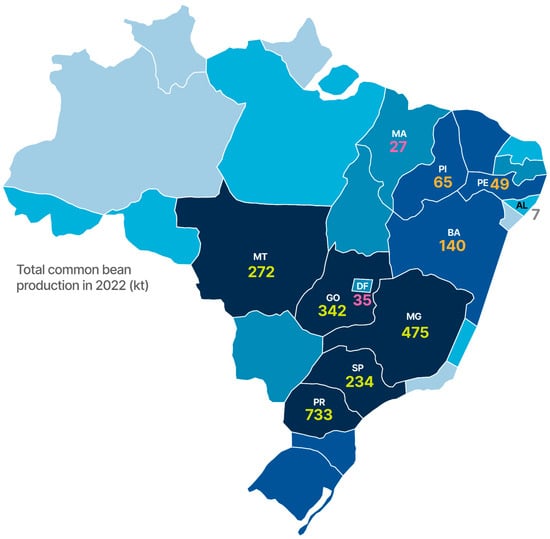
Figure 1.
Common bean production (ha) in some of the largest bean-producing Brazilian states in 2022: PR: Paraná, MG: Minas Gerais, GO: Goiás, MT: Mato Grosso, SP: São Paulo, BA: Bahia, PI: Piauí, PE: Pernambuco, DF: Distrito Federal, and MA: Maranhão [4].
2.2. Sampling Procedure
An online anonymous survey consisting of 32 questions designed to assess how producers and consultants approach pest management in common bean crops was created and shared using Google Forms (File S1), so that every respondent could enter their answers online, using a smartphone or a computer. The initial approach was to share the link to the online questionnaire with discussion groups of producers/consultants in instant message apps. As the response rate using this approach was lower than expected, an individualized approach was adopted to increase responses, contacting interviewees one by one, by phone, through instant messaging apps and at events related to common bean production in different Brazilian regions. Then, a snowball sampling technique was implemented to obtain answers from different regions of Brazil. The contact details of the first farmers interviewed by our research team were obtained through personal communication with other farmers, groups of consultants, technicians, and researchers. From then on, each interviewee indicated other potential respondents, which expanded the scope of application of the questionnaire. Most of the responses were entered online. Some preferred to answer in person, in interviews held at technical events, while others preferred to answer questions over the phone.
2.3. Methodological Concerns
Sample representativeness: The sample includes 11 states but overrepresents Goiás (20.2%), because this state is where the investigators are based. However, this should not affect the generalizability of the observed results, considering that the samples collected from this state represent farmers who adopt different levels of technology and grow common beans in areas of varying sizes, which also occur in other regions of the country.
Production systems vary more significantly with the farm size than between states. Therefore, analyzing data based on farm size helps to reduce potential biases arising from the overrepresentation of individual states.
Self-reported data: Potential social desirability bias may occur (e.g., farmers overreporting IPM adoption). Social desirability bias is the tendency for people to answer questions in surveys or studies in a positive way, even if it does not reflect their true opinions or behavior, thus potentially distorting the research results. However, our questionnaire was designed to present questions with similar meanings repeatedly, in different ways, to cross-reference information that confirms the answers given by the interviewees, thus capturing possible biases.
Snowball sampling technique: The snowball sampling technique may introduce certain biases, such as the overrepresentation of individuals with similar profiles, potentially leading to distorted or non-representative results. To mitigate these biases, we sought referrals from individuals with diverse profiles and geographical backgrounds. Nevertheless, since the target population consisted exclusively of producers and consultants involved in common bean production—who tend to share similar characteristics, there were inherent limitations in diversifying respondent profiles beyond this crop.
2.4. Data Analysis
The answers’ dataset was revised and imported into IBM SPSS Statistics 27 [21] and Microsoft Excel [22]. Most of the data analysis consisted of descriptive analysis, mainly using frequency tables, to identify the main characteristics of bean growers and consultants regarding adopting technologies related to IPM.
For the questions about IPM adoption, the use of preventive insecticide applications, cooperative membership, and willingness to spend on a technology that reduced insecticide use, the distribution of respondents across farm size classes was compared using the chi-square test. When significant differences were detected, adjusted standardized residuals were analyzed to identify which specific groups contributed to the observed differences. These statistical analyses were performed using R software (version 4.5.0, 2025-04-11 ucrt) [23].
2.5. Concepts Used in the Analysis
IPM adoption: In this study, integrated pest management (IPM) is considered adopted when the producer monitors pest population levels prior to making decisions regarding the application of control measures, such as chemical pesticides or biological agents. This definition aligns with core IPM principles, which emphasize informed, threshold-based interventions. Preventive insecticide applications: These refer to insecticide treatments applied according to a fixed calendar schedule, often synchronized with the application of other agricultural inputs such as herbicides and fungicides. Typically performed on pre-determined dates, this practice is intended to optimize the use of spraying equipment and labor. However, such applications are conducted without a prior assessment of pest population levels and thus do not confirm whether pest thresholds necessitate control actions.
3. Results
3.1. Respondents Profile
In total, we received 103 responses, most of them (64.1%) directly from common bean producers. A smaller number of interviewees (35.9%) were agronomists responsible for technical assistance in the common bean production area on large and small farms. Most respondents were males (94.3%), common bean producers and declared to have technical assistance in the crop production (Figure 2). The percentage of respondents who are cooperative members (~51%) was not significantly different than that of non-members. Although the number of IPM adopters among the cooperative members was higher, there was no significant effect of cooperative membership on the IPM adoption rate. The percentage of respondents participating in a cooperative did not differ significantly across farm size classes, ranging from 42% to 60%. Interestingly, although most of the respondents own their land, it has become common in different Brazilian regions for farm owners to not live on the farm, but rather in a nearby town.
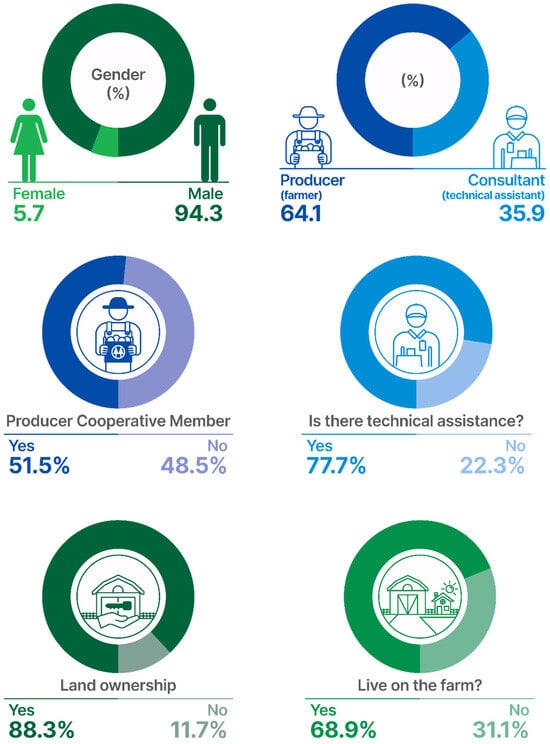
Figure 2.
Profile of respondents to the survey on IPM adoption in common beans in Brazil.
We received responses from producers/consultants from 11 Brazilian states (Figure 3) and 64 towns (Table S1). Most of the respondents were from the state of Goiás (20.2%), (Figure 3). This percentage includes the farmers from the region around the Federal District (DF). In general, the number of respondents was evenly distributed among the other great common bean producer states (Minas Gerais—MG, Paraná—PR, Mato Grosso—MT, São Paulo—SP, and Bahia—BA).
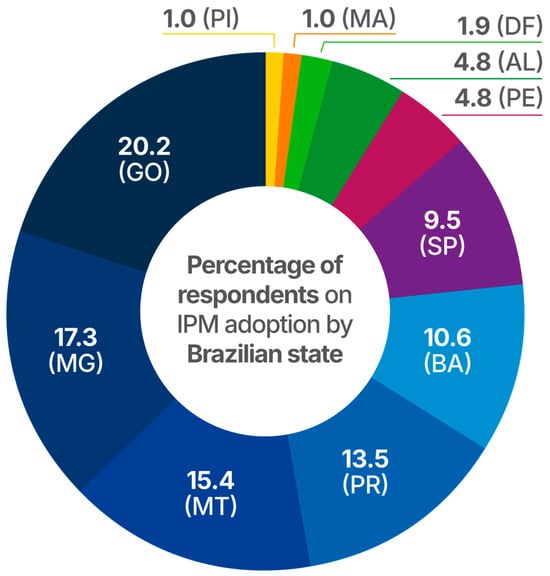
Figure 3.
Percentage of respondents to the survey on IPM adoption in pest management in common beans by Brazilian state (GO: Goiás, SP: São Paulo, BA: Bahia, PR: Paraná, MT: Mato Grosso, MG: Minas Gerais).
The study sample includes different sizes of common bean cultivation areas, from 1 ha to more than 500 ha (Table 1). Within this heterogeneous sample, there are interesting patterns related to the main sources of technical knowledge in agriculture. The family tradition in growing beans is important regardless of the cultivated area size. However, for farmers with bean cultivation areas larger than 101 ha, know-how obtained by family tradition is usually combined with other sources (e.g., professional training in agriculture). Indeed, professional training in agriculture is pointed out as an important source of technical knowledge by all cultivation area size groups, with an increasing importance for larger cultivation areas. Other sources of information like magazines, newspapers, and TV are also relevant in all cultivation area size classes. The interaction with other farmers is also a relevant source of information, especially for farmers with cultivating areas of 11 to 50 ha and for those with 500 ha and more.

Table 1.
Sources of technical knowledge in agriculture by the size of area (ha) cultivated with common beans in Brazil (2022–2024). The percentages presented in the columns reflect multiple responses and therefore do not sum to 100%, except for the percentage of farmers within each farm size class, which represents a single-response category.
The labor force used for common bean production is diverse. Usually, farmers with smaller cultivation areas rely mainly on family labor, while larger areas use a combination of family labor and hired labor. At farms with larger cultivation areas, hired labor provides the main labor force (Figure 4).
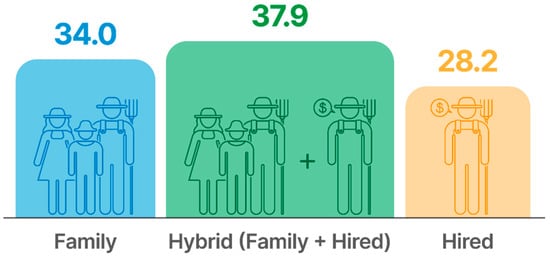
Figure 4.
Type of labor used in the cultivation of common beans in Brazil.
When asked how often they grow common beans, the majority (75.7%) do so annually (Figure 5). Some farmers (8.7%) responded that they grow beans every two years or only when prices are good (occasional growers).
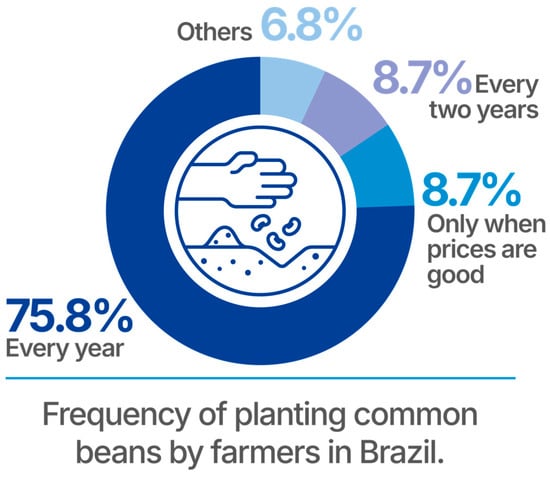
Figure 5.
Frequency of common bean cultivation by farmers in Brazil.
3.2. IPM Adoption by Common Bean Producers in Brazil
The common bean is produced in Brazil in three cropping seasons. Usually, farmers opt to grow common beans in one of the cropping seasons, depending on the climate of their geographic region. For example, in Central Brazil, most farmers cultivate common beans in the winter season, under central pivot irrigation. In the other cropping seasons, the production is diversified, including other crops, such as maize, soybean, vegetables, and cotton. Our results show that 56.3% of farmers who cultivate the common bean in one of the cropping seasons adopt IPM in their farm (not necessarily in the common bean cultivation) (Table 2). However, an impressive percentage of 43.7% affirmed they did not use IPM. No-tillage and crop rotation are the most common technologies adopted by these farmers.

Table 2.
Agriculture technologies adopted by farmers who produce common beans, among other crops, in Brazil. The percentages refer to the adoption of the technology in common beans or other crops cultivated by the respondents.
When asked if they use IPM on common beans, 89.3% of the respondents affirmed they do (Figure 6A). However, among those reporting IPM adoption, 42.7% of the total respondents also stated that they apply insecticides on a scheduled, preventive basis, while a similar proportion (46.6%) reported that they do not (Figure 6A). Preventive application refers to the use of insecticides without prior pest monitoring. Since monitoring arthropod populations is a fundamental component of IPM, we consider that respondents who apply insecticides preventively, i.e., without conducting pest monitoring, do not genuinely implement IPM. Based on this criterion, only 46.6% of respondents can be considered true adopters of IPM in common bean cultivation. When analyzing responses by farm size, statistically significant differences were observed only within the 1–5 ha category (very smallholders), both in reported IPM adoption and in the use of calendar-based insecticide applications (Figure 6B,C). Interestingly, all respondents with farms larger than 51 ha reported adopting IPM (Figure 6B). However, these larger farm size classes also showed the lowest proportions of respondents who avoid preventive insecticide applications (Figure 6C).
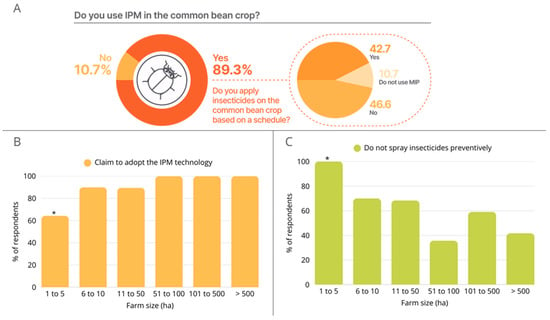
Figure 6.
Pest management practices among common bean farmers in Brazil. (A) Reported adoption of integrated pest management (IPM) by all respondents; (B) IPM adoption by respondents stratified by farm size (ha); and (C) percentage of respondents, by farm size, who reported not applying insecticides on a calendar-based schedule. * Statistically significant difference observed by the chi-square test (p < 0.001).
From the 89% of farmers that claim to use IPM in the common bean crop, 34.0% have used it for 1–5 years, 16.5% for 5–10 years, and 29.1% for over 10 years (Figure 7). Most respondents (55.3%) monitor the crop once weekly, while 35.0% monitor more than once per week and 2.9% every two weeks. Typically, the IPM strategy suggests weekly monitoring, but different frequencies may be used depending on the situation. For example, in cases of increasing infestations, it may be necessary to monitor the crop more frequently, such as twice a week.

Figure 7.
IPM adoption in the common bean crop in Brazil.
3.3. Use of IPM Tools by Common Bean Producers in Brazil
Pest monitoring is still mostly performed manually by a trained field technician called a pest (or IPM) monitor. At least once a week, this technician walks through the crop area, taking samples and recording the number of pests and beneficial insects found at each sampling point. Despite many advances in the use of automation to monitor other types of biotic stress, automated pest monitoring is still a challenge. This is because insects are generally very small and therefore difficult to detect in images taken at a height of 40 m by a drone, for example, in addition to the fact that most pests feed on the abaxial surface of the leaf. Therefore, most farmers that adopt IPM must monitor the crop themselves or hire pest monitors for large areas.
In our survey, the percentage of respondents who consider the cost of hiring an IPM monitor to be worth it in relation to the preventive application of insecticides is similar to the percentage of those who think otherwise (40.8% vs. 35%) (Figure 8A). This result shows that the perception of costs of a large percentage of farmers do not consider medium and long-term environmental costs, as if the two different strategies (monitoring the pest population to decide whether to apply insecticides versus applying insecticides preventively) were interchangeable. Also, it is remarkable that almost one fifth of the respondents do not know what their costs are with pest monitoring (Figure 8A). Interestingly, at the same time, a great majority of the respondents (86.4%) agreed that IPM reduces the costs related to pest control and benefits related to the agroecosystem, which indicates that farmers are aware of the benefits of reducing the use of insecticides (Figure 8B).
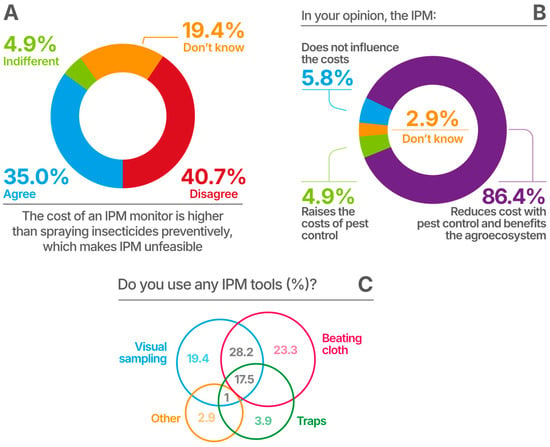
Figure 8.
Use of IPM tools in the common bean crop in Brazil and farmers’ perception of costs associated with IPM. (A) Perception of costs associated with hiring an IPM monitor; (B) perception of costs associated with IPM; and (C) frequency of farmers that adopt one or more IPM tools for crop monitoring.
Among the farmers that claim to use IPM, the great majority indicate that they use at least one of the most common IPM tools for pest monitoring, such as the beating cloth (23.3%), visual sampling (19.4%), and insect traps (3.9%) (Figure 8C). However, 28.2% of the respondents combine the use of the beating cloth and visual sampling, while 17.5% combine the beating cloth, visual sampling, and the use of traps. Interestingly, a few of those who claimed to not to use IPM affirmed that they use the visual sampling of the crop.
3.4. Perception of IPM Adoption Benefits
Although a high percentage of respondents said they do not use IPM on the common bean or on the other crops (about 47%), most respondents believe that adopting IPM is essential to ensure good productivity (87.4%), in addition to being useful and effective (87.4%) (Figure 9). The great majority (94.2%) of the respondents agree that agriculture management techniques such as crop rotation and succession influence the occurrence of pests in the common bean crop. However, when asked about the potential of preventively applying insecticides to reduce crop losses, opinions are divided, with similar percentages of respondents agreeing, disagreeing, or partially agreeing (Figure 10).
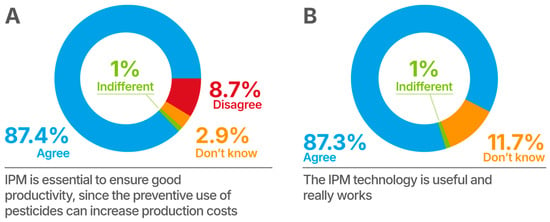
Figure 9.
Perception of common bean producers/consultants about the benefits of using IPM in common beans in Brazil, about (A) benefits of IPM to productivity and (B) efficacy of IPM.
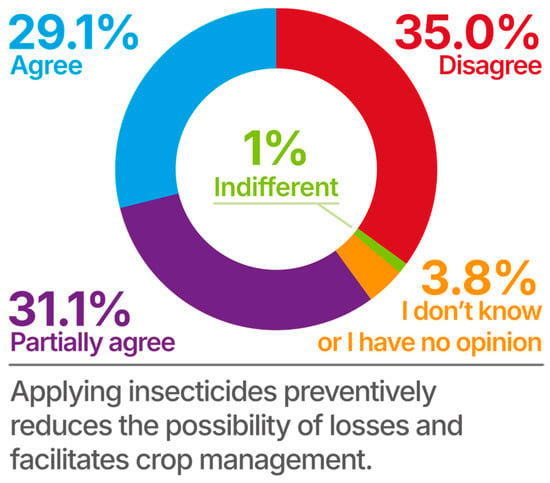
Figure 10.
Perception of Brazilian common bean producers/consultants about the benefits of applying insecticides preventively.
3.5. Willingness to Adopt Novel Technologies
A significantly higher percentage of the respondents (61.2%) would be willing to spend only up to 5% of the production cost on novel technologies, with the potential to reduce the risk and the number of insecticide applications (Figure 11A). Some (27.2%) would be willing to spend up to 10% of the production cost on such technologies, while very few (~5% of respondents) would spend over 20%. Strikingly, a significantly higher percentage of the respondents (<40%) said they already spend 20% of the crop production costs with pest management, i.e., mostly on insecticides (Figure 11A). This percentage, reported by producers, is lower than that reported by the Brazilian agriculture census (IBGE), which shows that, in general, the costs with pest management in common beans are about 30% of the total production costs [7]. A significantly greater proportion of producers managing farms larger than 51 hectares indicated a willingness to invest no more than 5% of total production costs in technologies designed to reduce insecticide application (Figure 11B). In contrast, responses among smallholders were more varied, indicating that these farmers would invest higher amounts on more sustainable technologies.
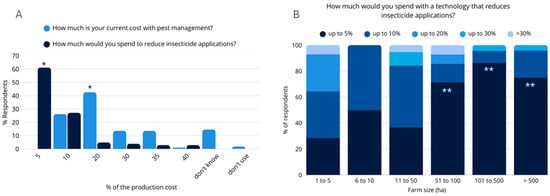
Figure 11.
Current pest management costs reported by Brazilian common bean producers and consultants, along with the estimated percentage of production costs they would be willing to invest in sustainable pest management techniques. (A) Percentage of total respondents. * Statistically significant differences among columns of the same color observed by the chi-square test (p < 0.001). (B) Percentage of respondents by farm size. ** Statistically significant differences within the same column observed by the chi-square test (p < 0.001).
Finally, almost 40% of the respondents said they would be interested in adopting automated pest monitoring tools, depending on the costs (Figure 12). In contrast, almost 100% of the respondents said they would be willing to adopt IPM if there was a certification that added value to products obtained with low insecticide use. This raises another relevant strategy to increase the adoption of IPM and other sustainable techniques.
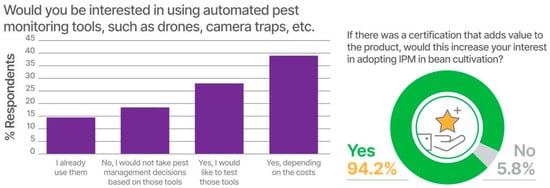
Figure 12.
Technologies and incentives that would increase producers’ interest in adopting IPM in the common bean crop in Brazil.
4. Discussion
Integrated pest management (IPM) is a widely known technology, available since the late 1950s [10,11,12]. The concept of IPM involves monitoring the crop to determine the occurrence of arthropods (pests or beneficial) and checking whether the pest population level reaches the Economic Threshold (ET), that is, if it is time to act towards pest management. When farmers decide to apply pesticides in a preventive way, without monitoring the field for pest occurrence, they are not following the basic concept of IPM technology. Applying insecticides before the pests reach the ET can be harmful to ecosystem balance and increase production costs. In our survey, a large proportion of respondents reported adopting IPM in common bean cultivation. However, when asked whether they apply pesticides preventively, approximately half of these self-identified IPM adopters indicated that they do. This shows that the actual IPM adoption rate is lower than expected, about 46%. In fact, the adoption of IPM has decreased over the years, as shown for soybean in Brazil [24]. The estimated adoption rate observed in the present study is higher than that reported in a study on Capsicum sp. (39.81%) in Kenya [25], but lower than the reported rate of adoption by corn growers in the USA (50%) [26] and olive growers in Iran (54%) [27]. To increase the IPM adoption rate, it is crucial that the farmers understand that integrating non-chemical management alternatives to chemical control, which should be judiciously applied, is beneficial to their productivity as well as to the environment [28].
A study with apple farmers from China showed that cooperative membership increases the adoption of IPM [29]. However, our results do not show a relationship between cooperative membership and IPM adoption, which may be because there was no difference between the percentages of cooperative members and non-members. Although 100% of large-scale farmers (farms > 51 ha) affirmed that they adopt IPM in the present study, our results also show a trend for fewer small-scale farmers to adopt preventive insecticide applications, although the difference was significant only for very smallholders (1–5 ha farms). This result indicates that the probability of IPM adoption declines with an increased farm size, which had been demonstrated before [30]. This is the opposite of what was observed in a study with olive fruit fly IPM adoption in Iran, where large-scale farmers were more prone to adopt IPM [27]. In the present study, the low IPM adoption by common bean farmers/consultants in Brazil can be associated with three main factors, based on our study: (1) the lack of understanding of IPM concepts; (2) the widespread cultural belief that the use of insecticides is the most efficient pest management method, regardless of the costs, and last but not least, (3) the costs associated with monitoring the crop for arthropod populations.
First, although the idea of IPM has been well accepted by farmers worldwide, our results show that the IPM concepts are not well understood by farmers and consultants. Most respondents in our study claim (1) to know the integrated management of common bean pests, (2) that IPM is highly recommended by their consultants, and (3) that they use the IPM technology in the production of common beans. However, our results show that producers do not fully understand the basic concepts of IPM, which may be one of the reasons for the low adoption of this technology, as shown in several other studies [15,31,32]. For example, it became clear that a large percentage of the respondents do not understand that the preventive application of insecticides is at odds with the basic IPM concept of applying insecticides only when the pest population reaches the ET. It is also possible that the ET has not been defined for some pests, such as the whitefly, one of the most important bean pests, or the ETs have been defined a long time ago and need to be updated [19]. The lack of this information may lead producers to not trust the IPM technology and, therefore, carry out preventive applications, since they have nothing to base their decision on, and they are afraid of the risks associated with the occurrence of this pest. Considering that a large percentage (>95%) of respondents stated that they use at least one of the IPM monitoring tools and that more than half affirmed to monitor the crop once a week, we conclude that farmers intend to apply IPM technology, as they understand the benefits to the ecosystem. However, probably due to the lack of information, farmers feel uncomfortable making decisions based on pest monitoring. Similar studies developed with Capsicum sp. producers from Kenya, rice producers from India, state IPM coordinators from the USA, and small-scale farmers from Uganda showed that knowledge transfer by extension programs and training on pest management are key to a better understanding of the IPM concepts and advantages, which could increase IPM adoption by farmers [25,31,32,33]. A widely known initiative is the Farmer Field School (FFS) developed by the FAO over 30 years ago, which is a group-based experiential learning approach for training farmers to apply the principles of IPM in developing countries in Asia and Latin America [34]. Over the years, the FFS initiative contributed to reduce the reliance on pesticides and promote a learning culture at the community level. In another study, a survey with Peruvian potato farmers showed that farmers who received information about IPM via mobile phone text messages adopted IPM practices at a significantly higher rate than control farmers, who did not receive the messages [15]. The quality of communication was also a caveat for IPM adoption in a study with growers from Costa Rica, Nepal, and Malawi [16]. These results suggest that the low IPM adoption estimated in the present study is probably associated with a lack of information and not with a lack of awareness, ranked as a relevant barrier to IPM adoption in another study [32].
There is yet another important factor, related to the deep-rooted culture that insecticides are the most effective method for pest management, regardless of the associated financial costs (not to mention the environmental costs) [13,16]. The overreliance on chemical insecticides has been presented as a critical factor for the low IPM adoption rate in other studies as well [25,32]. The intensive use of pesticides in agriculture was introduced by the so-called green revolution of the 1960s and 1970s, which established a high dependence of agricultural production on these inputs [35]. In addition, this event contributed to a significant increase in agricultural productivity worldwide, with major advances in crop breeding genetics, developing higher-yielding crop varieties, some with resistance to pests and pathogens. However, this agricultural system did not lead to the sustainable management of natural resources, nor to food security. On the contrary, the more the need to use chemical inputs increases, the more negative effects are perceived on the ecosystem balance [25]. However, it cannot be denied that the use of pesticides is convenient [19], since they are easy to apply, with well-established protocols, and bring results that are quickly noticed by the farmers. IPM coordinators from the USA ranked the difficulty of implementation as one of the most important barriers to IPM adoption [32]. Together, these conveniences favor the use of pesticides, which are perceived as an effective pest control method by farmers, even if the costs are higher than necessary. Our results show that the farmers’ opinions are divided regarding the potential benefits of preventively applying insecticides to reduce crop losses. Even so, their responses show that they do apply insecticides in a preventive manner, based on a calendar and not on the pest population levels. Another indication that farmers, in general, are overly reliant on insecticides is that a very small proportion of the respondents (<5%) affirmed they would be willing to spend over 20% of production costs on technology that would help reduce the number of insecticide applications. Yet, they already spend at least 20% on chemical control. When these data are analyzed by farm size categories, we observed that a significantly higher proportion of producers managing farms larger than 51 hectares reported applying insecticides preventively. These farmers also indicated that they would not be willing to invest more than 5% of their production costs in technologies aimed at reducing insecticide use. In contrast, responses among smallholders were varied, suggesting a greater willingness to invest in new technologies—possibly driven by the general scarcity of technologies specifically adapted to small-scale farming. These data suggest that, in general, farmers are still conservative in relation to novel technologies and consider that insecticides are the most effective management strategy, which they are confident to adopt, even if the costs are high. This also shows that, in general, farmers are not aware of how much they spend with preventive applications of insecticides. For a paradigm shift, it is essential that farmers and consultants trust in alternative solutions to the preventive use of pesticides, with the presentation of scientific data showing it is possible to reduce the use of insecticides and the production costs. This leads to the third relevant issue related to the low adoption of IPM: the costs associated with adopting IPM, which has been demonstrated as one of the main factors affecting the adoption of this technology, such as in the case of the olive growers in Iran [27]. In the case of the common bean, although the Brazilian exports have increased in recent years, most of the bean production is still consumed domestically. Therefore, the common bean market in Brazil is driven primarily by domestic consumption, with significant price fluctuations, particularly with the commercial type of ‘carioca’ beans. As a result, common bean producers are strongly influenced by the current crop market value, both in terms of deciding whether to plant and how much to spend on crop management, as shown by our results. For example, although most respondents cultivate common beans every year, ~9% of farmers cultivate the crop only when prices are favorable, compared to other crops. A high proportion of the respondents consider the costs of pest monitoring to be higher than preventive spraying, and therefore prohibitive, although the majority agree that IPM might help reduce the costs of pest control. Most of them agree that preventive insecticide spraying can increase production costs (even so, a high percentage is willing to pay the price) and more than 40% of the respondents affirmed that their current cost with pest management is about 20% of production costs. These contradictions again point to producers’ overreliance on chemical pesticides. Also, these findings corroborate other studies, which showed that one of the main barriers to IPM adoption was the high cost of practice or labor [14,17,32]. Farmers justify preventive insecticide applications as a cost-saving strategy by considering operational expenses. They argue that adopting schedule-based insecticide applications is worthwhile, as insecticides are applied alongside herbicides and fungicides in a single treatment, streamlining the process and reducing costs [19]. However, as stated by these authors, spraying insecticides before the pest population reaches the ET can be ineffective, increase the selection of pest populations resistant to insecticides, and makes the use of ET obsolete [35].
Finally, most respondents expressed interest in adopting automated technologies and implementing IPM, provided the associated costs are manageable and there is potential for added value—an observation consistent with findings from other IPM adoption surveys [18,36]. One example of such added value is the quality certification of common beans produced under IPM guidelines, which emphasizes the reduced use of chemical insecticides, minimizes environmental impact, and offers a healthier product to consumers. The development and widespread recognition of a certification seal could serve as a valuable tool to enhance the market appeal of sustainably produced beans. In Brazil, an integrated production system for common beans was developed to promote the sustainability, traceability, and certification of production practices [37]. However, despite its potential, this system has not been widely adopted—likely due to insufficient government incentives and a lack of supporting public policies.
Since beans are primarily produced for domestic consumption in Brazil, they lack the same certification appeal as export-oriented commodities. For a quality certification program for common bean production to be truly beneficial, it would need to be supported by government incentives. These could include priority access to agricultural credit and the inclusion of certified beans as a preferred item in public procurement programs, such as those supplying school meals. In a study developed with apple producers from Morocco, it was demonstrated that farmers would be interested in adopting a more sustainable production system, including IPM, if the practice facilitates the commercialization of their products [36]. Taken together, these results indicate that costs and profits are the main drivers of the decision on whether to adopt certain technologies, especially novel and not yet fully established ones. Recently, the availability of precision application technologies has the potential to reduce insecticide spraying to targeted areas, where the pests may effectively create damage to the crop, which is certainly of interest to farmers. To do this safely, it is recommended to frequently monitor the total area, identifying the focus of pest infestation, preferably at the initial stages to take assertive pest management actions. These automated tools are considered novel and not yet established. However, our results indicate that IPM is also seen as a yet unestablished technology, which producers do not yet fully trust.
In summary, the most relevant actions to increase the level of IPM adoption, based on our results, are as follows: (1) extension programs to transfer knowledge about basic concepts and advantages of adopting IPM, as well as the negative impacts associated with excessive insecticide use; (2) scientific data showing the benefits of reducing the use of insecticides on production costs and net income; (3) establishing and/or reviewing the Economic Threshold for important common bean pest species; (4) developing automated tools for pest monitoring, aiming to reduce the costs; and (5) public policies or product quality certification to encourage the rational management or non-use of pesticides.
5. Conclusions
The estimated adoption rate of IPM by bean producers in Brazil is 46.6%.
The low adoption of IPM among common bean producers in Brazil is related to three main factors: (1) a lack of understanding of IPM concepts; (2) the overreliance on chemical insecticides as the most efficient pest management method; and (3) the high costs associated with crop monitoring of arthropod population levels.
IPM is not perceived as a well-established technology by common bean farmers in Brazil.
The results presented in this study can be used to support the discussion of public policies and new scientific research, aiming at increasing IPM adoption by Brazilian farmers.
Supplementary Materials
The following supporting information can be downloaded at: https://www.mdpi.com/article/10.3390/horticulturae11060611/s1, Table S1. Total number and percentage of respondents to the survey on IPM adoption in common bean and the total production of this crop in 2022, in each town represented in the study [4]. File S1. Questionnaire used to collect information on pest management in bean cultivation in Brazil and the level of IPM adoption by producers and consultants. The original questionnaire was shared online with interviewees by the Google Form, in Portuguese. The text presented here is a faithful translation of the questions into English, for publication purposes.
Author Contributions
Conceptualization, P.V.P.; methodology, P.V.P. and A.L.F.; formal analysis, P.V.P., A.L.F. and A.E.W.; investigation, P.V.P. and A.L.F.; resources, P.V.P.; writing—original draft preparation, P.V.P.; writing—review and editing, P.V.P., A.L.F. and A.E.W.; project administration, P.V.P.; funding acquisition, P.V.P. All authors have read and agreed to the published version of the manuscript.
Funding
This research was funded by Embrapa Arroz e Feijão, grant number 20.20.03.003.00.00.
Data Availability Statement
Partial dataset available on request due to restrictions regarding the personal data protection Brazilian law.
Acknowledgments
The authors would like to thank all the interviewees who were willing to answer the questionnaire and especially those who kindly help direct the questionnaire to other potential respondents, such as Ademir Calegari, Luciene F. C. de Oliveira and Pedro H. Lopes Sarmento. We also thank Fabio Noleto for designing the figures and tables.
Conflicts of Interest
The authors declare no conflicts of interest.
References
- Uebersax, M.A.; Cichy, K.A.; Gomez, F.E.; Porch, T.G.; Heitholt, J.; Osorno, J.M.; Kamfwa, K.; Snapp, S.S.; Bales, S. Dry beans (Phaseolus vulgaris L.) as a vital component of sustainable agriculture and food security—A review. Legume Sci. 2023, 5, e155. [Google Scholar] [CrossRef]
- Singh, S. Common bean (Phaseolus vulgaris L.). In Genetic Resources, Chromosome Engineering, and Crop Improvement; CRC Press: Boca Baton, FL, USA, 2005; Volume 1, ISBN 978-0-367-38240-7. [Google Scholar]
- Cortés, A.J. On the origin of the common bean (Phaseolus vulgaris L.). Am. J. Plant Sci. 2013, 4, 1998–2000. [Google Scholar] [CrossRef]
- Instituto Brasileiro de Geografia e Estatística (IBGE). Levantamento Sistemático da Produção Agrícola—LSPA. Available online: https://www.ibge.gov.br (accessed on 31 March 2025).
- Food and Agriculture Organization of the United Nations (FAO). Bean Production—FAO [Dataset]. “Production: Crops and Livestock Products” [Original Data]. Available online: https://ourworldindata.org/grapher/bean-production (accessed on 12 March 2025).
- Instituto Brasileiro de Geografia e Estatística (IBGE). Censo Agropecuário. Available online: https://censoagro2017.ibge.gov.br/ (accessed on 31 March 2025).
- Companhia Nacional de Abastecimento (CONAB). Planilhas de Custo de Produção—Feijão [Production Costs Sheets—Beans]. Available online: https://www.conab.gov.br/info-agro/custos-de-producao/planilhas-de-custo-de-producao/itemlist/category/809-feijao (accessed on 31 March 2025).
- Souza, T.L.P.O.; Faria, J.C.; Aragão, F.J.L.; Peloso, M.J.D.; Faria, L.C.; Wendland, A.; Aguiar, M.S.; Quintela, E.D.; Melo, C.L.P.; Hungria, M.; et al. Agronomic performance and yield stability of the RNA interference-based bean golden mosaic virus-resistant common bean. Crop Sci. 2018, 58, 579–591. [Google Scholar] [CrossRef]
- Demeneix, B.A. How fossil fuel-derived pesticides and plastics harm health, biodiversity, and the climate. Lancet Diabetes Endocrinol. 2020, 8, 462–464. [Google Scholar] [CrossRef]
- Smith, R.; van den Bosch, R.; Hagen, K.; Stern, V. The integration of chemical and biological control of the spotted alfalfa aphid: The integrated control concept. Hilgardia 1959, 29, 81–101. Available online: https://scispace.com/pdf/the-integration-of-chemical-and-biological-control-of-the-pcl1r74huk.pdf (accessed on 31 March 2025). [CrossRef]
- Stern, V.M.; Smith, R.F.; Van Den Bosch, R.; Hagen, K.S. The Integrated Control Concept. Available online: https://garfield.library.upenn.edu/classics1985/A1985ASA4600002.pdf (accessed on 31 March 2025).
- Smith, R.F. The importance of economic injury levels in the development of integrated pest control programs. Qual. Plant. Mater. Veg. 1969, 17, 81–92. [Google Scholar] [CrossRef]
- Ryalls, J.M.W.; Garratt, M.P.D.; Spadaro, D.; Mauchline, A.L. The benefits of integrated pest management for apple depend on pest type and production metrics. Front. Sustain. Food Syst. 2024, 8, 1321067. [Google Scholar] [CrossRef]
- Gonzalez, F.; Rodríguez, C.; Oehlschlager, C. Economic benefits from the use of mass trapping in the management of diamondback moth, Plutella xylostella, in Central America. Insects 2023, 14, 149. [Google Scholar] [CrossRef]
- Larochelle, C.; Alwang, J.; Travis, E.; Barrera, V.H.; Andrade, J.M.D. Did you really get the message? Using text reminders to stimulate adoption of agricultural technologies. J. Dev. Stud. 2019, 55, 548–564. [Google Scholar] [CrossRef]
- Bentley, J.W.; Danielsen, S.; Phiri, N.; Tegha, Y.C.; Nyalugwe, N.; Neves, E.; Hidalgo, E.; Sharma, A.; Pandit, V.; Sharma, D.R. Farmer responses to technical advice offered at plant clinics in Malawi, Costa Rica and Nepal. Int. J. Agric. Sustain. 2018, 16, 187–200. [Google Scholar] [CrossRef]
- Aristizábal, L.F.; Johnson, M.; Shriner, S.; Hollingsworth, R.; Manoukis, N.C.; Myers, R.; Bayman, P.; Arthurs, S.P. Integrated pest management of coffee berry borer in Hawaii and Puerto Rico: Current status and prospects. Insects 2017, 8, 123. [Google Scholar] [CrossRef]
- Chaves, B.; Riley, J. Determination of factors influencing integrated pest management adoption in coffee berry borer in Colombian farms. Agric. Ecosyst. Environ. 2001, 87, 159–177. [Google Scholar] [CrossRef]
- Bueno, A.F.; Panizzi, A.R.; Hunt, T.E.; Dourado, P.M.; Pitta, R.M.; Gonçalves, J. Challenges for adoption of integrated pest management (IPM): The soybean example. Neotrop. Entomol. 2021, 50, 5–20. [Google Scholar] [CrossRef]
- Gill, H.K.; Goyal, G. Integrated Pest Management (IPM): Environmentally Sound Pest Management; BoD—Books on Demand: Norderstedt, Germany, 2016; ISBN 978-953-51-2612-6. [Google Scholar]
- IBM Corp. IBM SPSS Statistics for Windows, Version 27.0; IBM Corp.: Armonk, New York, USA, 2020.
- Microsoft Corporation. Microsoft Excel, Version 2504; Microsoft Corporation: Redmond, WA, USA, 2025.
- R Core Team. R: A Language and Environment for Statistical Computing; R Core Team: Vienna, Austria, 2025. [Google Scholar]
- Bortolotto, O.C.; Pomari-Fernandes, A.; Bueno, R.C.O.F.; Bueno, A.F.; da Cruz, Y.K.; Sanzovo, A.; Ferreira, R.B. The use of soybean integrated pest management in Brazil: A review. Agron. Sci. Biotechnol. 2015, 1, 25. [Google Scholar] [CrossRef]
- Onamu, E.M.; Mutyambai, D.M.; Nyangau, I.M.; Nderitu, J.H.; Kasina, M.; Kilalo, D.C.; Mweke, A.N. Farmers’ knowledge, perceptions, and management practices of false codling moth (Thaumatotibia leucotreta) in smallholder Capsicum sp. cropping systems in Kenya. Horticulturae 2024, 10, 331. [Google Scholar] [CrossRef]
- Bryant, T.B.; Greene, J.K.; Reisig, D.; Reay-Jones, F.P.F. Grower perceptions and adoption of IPM and non-Bt refuge in field corn: A survey in North and South Carolina. J. Integr. Pest Manag. 2024, 15, 4. [Google Scholar] [CrossRef]
- Allahyari, M.S.; Damalas, C.A.; Ebadattalab, M. Determinants of integrated pest management adoption for olive fruit fly (Bactrocera oleae) in Roudbar, Iran. Crop Prot. 2016, 84, 113–120. [Google Scholar] [CrossRef]
- Bottrell, D.G.; Schoenly, K.G. Integrated pest management for resource-limited farmers: Challenges for achieving ecological, social and economic sustainability. J. Agric. Sci. 2018, 156, 408–426. [Google Scholar] [CrossRef]
- Ma, W.; Abdulai, A. IPM adoption, cooperative membership and farm economic performance: Insight from apple farmers in China. China Agric. Econ. Rev. 2018, 11, 218–236. [Google Scholar] [CrossRef]
- de Souza Filho, H.M. The Adoption of Sustainable Agricultural Technologies: A Case Study in the State of Espírito Santo, Brazil, 1st ed.; Routledge: Aldershot, UK; Brookfield, WI, USA; Singapore, 1997; ISBN 978-1-84014-160-3. [Google Scholar]
- Clausen, A.S.; Jørs, E.; Atuhaire, A.; Thomsen, J.F. Effect of integrated pest management training on Ugandan small-scale farmers. Environ. Health Insights 2017, 11, 1178630217703391. [Google Scholar] [CrossRef] [PubMed]
- Lane, D.E.; Walker, T.J.; Grantham, D.G. IPM adoption and impacts in the United States. J. Integr. Pest Manag. 2023, 14, 1. [Google Scholar] [CrossRef]
- Sun, X.; Lyu, J.; Ge, C. Knowledge and farmers’ adoption of green production technologies: An empirical study on IPM adoption intention in major indica-rice-producing areas in the Anhui province of China. Int. J. Environ. Res. Public. Health 2022, 19, 14292. [Google Scholar] [CrossRef] [PubMed]
- Sarapura, S.; Chulunbataar, D.C. Institutionalizing Farmer Field School Approach: Experiences from Latin America; FAO: Rome, Italy, 2018; ISBN 978-92-5-130334-4. [Google Scholar]
- Hurley, T.M. Shock and awe pest management: Time for change. Choices Mag. Food Farm Resour. Issues 2016, 31, 1–8. [Google Scholar] [CrossRef]
- Moinina, A.; Lahlali, R.; MacLean, D.; Boulif, M. Farmers’ knowledge, perception and practices in apple pest management and climate change in the Fes-Meknes region, Morocco. Horticulturae 2018, 4, 42. [Google Scholar] [CrossRef]
- Barbosa, F.R.; Martins, F.A.D.; Oliveira, L.F.C.; Silva, A.G.; Gonzaga, A.C.O. Sistema de Produção Integrada do Feijão-Comum na Região Central Brasileira; Embrapa Arroz e Feijão: Santo Antônio de Goias, Brazil, 2018; Volume 245. [Google Scholar]
Disclaimer/Publisher’s Note: The statements, opinions and data contained in all publications are solely those of the individual author(s) and contributor(s) and not of MDPI and/or the editor(s). MDPI and/or the editor(s) disclaim responsibility for any injury to people or property resulting from any ideas, methods, instructions or products referred to in the content. |
© 2025 by the authors. Licensee MDPI, Basel, Switzerland. This article is an open access article distributed under the terms and conditions of the Creative Commons Attribution (CC BY) license (https://creativecommons.org/licenses/by/4.0/).